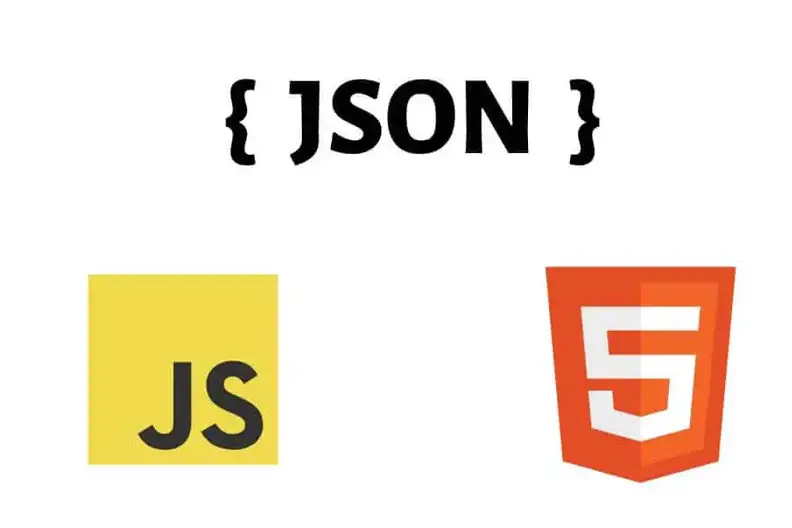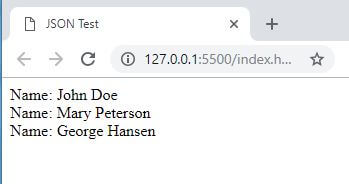Html Code Button Upload Cvs File With Json

In this tutorial, I will show you lot how to fetch and display data from a JSON file using vanilla JavaScript.
So how will nosotros achieve this?
Get-go, we will fetch the JSON information past using the fetch API. This will return a hope with our JSON data. And then we will suspend the data dynamically by creating HTML elements on the fly. We will and so append our JSON data to those elements.
Getting JSON information from an API and brandish it on a web folio is a common thing you will do quite oftentimes. I have created similar posts on the big frameworks like React, Vue and Athwart. Bank check it out if y'all are using whatever of those frameworks.
Let's get started!
Offset, create a people.json file and make full it with the post-obit data:
[ { "id": "1", "firstName": "John", "lastName": "Doe" }, { "id": "2", "firstName": "Mary", "lastName": "Peterson" }, { "id": "iii", "firstName": "George", "lastName": "Hansen" } ] We will relieve this file in the aforementioned directory every bit our alphabetize.html file.
Fetching the JSON information
To be able to brandish this information in our HTML file, we first demand to fetch the data with JavaScript.
Nosotros will fetch this data by using the fetch API. Nosotros apply the fetch API in the following style:
fetch(url) .then(role (response) { // The JSON data will arrive hither }) .catch(function (err) { // If an error occured, you will catch information technology hither }); url fetch people.json alphabetize.html
The fetch function will render a promise. When the JSON data is fetched from the file, the then function will run with the JSON data in the response.
If annihilation goes wrong (like the JSON file cannot exist plant), the catch role will run.
Let united states see how this will look in out example:
fetch('people.json') .and so(function (response) { render response.json(); }) .then(role (data) { appendData(information); }) .take hold of(function (err) { console.log(err); }); Here we are fetching our people.json file. After the file has been read from disk, we run the then function with the response as a parameter. To go the JSON data from the response, nosotros execute the json() function.
The json() function also returns a hope. This is why we just render it and concatenation some other then function. In the second so function we become the actual JSON data as a parameter. This information looks just similar the data in our JSON file.
Now we can have this data and display it on our HTML folio. Notice that nosotros are calling a function chosen appendData. This is where we create the code which will suspend the data to our page.
Notice that in our catch office, we are just writing the error message to out console. Normally you would display an error message to the user if something went incorrect.
Displaying the JSON information
Before we brandish our JSON data on the webpage, let'south just see how the body of our index.html file looks like.
<body> <div id="myData"></div> </body>
Pretty simple right? We have just a simple div with the id myData. Our plan is to fill our JSON data inside this div dynamically.
In that location are several ways to display the data in our HTML. We could create a table and make it look really expert with overnice styling. Nevertheless, we volition exercise this in a simple and ugly mode.
Our goal is to just simply display the full name of the people in our JSON file.
Step ane – Go the div element from the body
Remember the div with the myData id from index.html
This is how we will do information technology:
var mainContainer = document.getElementById("myData"); Nosotros get the chemical element by executing the getElementByID part. This volition discover the element with the id myData. This is vanilla JavaScript and this is how we did front-end evolution in the "former" days :).
Step two – Loop through every object in our JSON object
Next stride is to create a simple loop. We can then become every object in our list of JSON object and append it into our master div.
for (var i = 0; i < data.length; i++) { // suspend each person to our page } Step iii – Append each person to our HTML page
Inside the for-loop we will append each person inside its own div. This code will be repeated three times for each person.
First, we will create a new div chemical element:
var div = document.createElement("div"); Next we volition fill that div with the full name from our JSON file.
div.innerHTML = 'Name: ' + data[i].firstName + ' ' + data[i].lastName;
Lastly, we volition suspend this div to our main container:
mainContainer.appendChild(div);
That'southward it. Now we take finished appending the JSON information to our index.html page. The full appendData function looks like this:
function appendData(data) { var mainContainer = certificate.getElementById("myData"); for (var i = 0; i < data.length; i++) { var div = certificate.createElement("div"); div.innerHTML = 'Proper name: ' + data[i].firstName + ' ' + data[i].lastName; mainContainer.appendChild(div); } } When we run our index.html page, it will look something similar this:

Not the most beautiful application, merely it got the task done.
Allow the states expect at the entire HTML file with the JavaScript:
<!DOCTYPE html> <html lang="en"> <head> <meta charset="UTF-8"> <meta name="viewport" content="width=device-width, initial-calibration=1.0"> <meta http-equiv="10-UA-Uniform" content="ie=border"> <title>JSON Test</championship> </head> <body> <div id="myData"></div> <script> fetch('people.json') .then(function (response) { return response.json(); }) .then(function (data) { appendData(data); }) .grab(function (err) { console.log('mistake: ' + err); }); function appendData(data) { var mainContainer = document.getElementById("myData"); for (var i = 0; i < data.length; i++) { var div = document.createElement("div"); div.innerHTML = 'Name: ' + data[i].firstName + ' ' + data[i].lastName; mainContainer.appendChild(div); } } </script> </trunk> </html> Try to re-create and paste this in your own editor. As an practise, you lot can try to style the output to look nicer. Remember to include the people.json file also. This file must exist in the same directory equally your index.html file for this to work.
Why use 5anilla JavaScript?
You might be wondering what is the point of creating this in vanilla JavaScript. Doesn't modern spider web application use frameworks and libraries like Angular, ReactJS or VueJS?
Well, yeah, you are probably correct, most of the time. But some spider web pages are simply static with very fiddling logic.
If y'all only want to tweak some modest parts of the website, information technology might exist overkill to include big libraries which volition irksome down the site.
Besides, frameworks and libraries come and go. Good sometime vanilla JavaScript is here to stay. Then take every opportunity to learn it, you don't know when you might demand it.
Happy coding!
Source: https://howtocreateapps.com/fetch-and-display-json-html-javascript/
Post a Comment for "Html Code Button Upload Cvs File With Json"